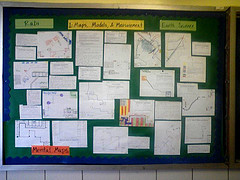Displaying Student Work
By Mary Bigelow
Posted on 2014-04-14
 I inherited a classroom-lab from a retired teacher, and I want to replace some of the generic posters with displays of student work. One of my colleagues says this is not a good idea. She didn’t explain her reasons, but now I’m not sure what to do.
I inherited a classroom-lab from a retired teacher, and I want to replace some of the generic posters with displays of student work. One of my colleagues says this is not a good idea. She didn’t explain her reasons, but now I’m not sure what to do.
—Therese, Charlotte, North Carolina
I’ve worked on statewide projects in which I had the opportunity to visit K-12 classrooms. The classrooms were generally very colorful; the bulletin boards and walls included motivational posters, teacher-created displays related to seasons or holidays, or artifacts related to the teacher’s interests. But I was surprised by the lack of student contributions. In some places, the student work was limited to cookie-cutter artwork (e.g., snowflakes, hearts, pumpkins). In some classrooms, every available inch was covered with something, which I found very distracting. And there were a few with completely bare walls.
By having students create the displays or showcasing student work, you show that you value student work and that the classroom really belongs to the students. Students have a chance to learn from and celebrate each other’s work, as they demonstrate connections to the current content or the processes they are learning.
I would check with your principal or department chairperson to see if there are any guidelines about displaying student work. (There are some schools where this is not allowed.)
The purpose of student displays is to reinforce students’ efforts and creativity, not necessarily to reward perfection. I would not display answer sheets from tests or quizzes or assignments with teacher-awarded final grades on them. Likewise, papers or projects with a simple “good job” comment don’t provide enough feedback on why they are on display.
Here are some suggestions:
- Most science teachers have a bulletin board with important safety rules and lab routines. Instead of purchasing posters or making the signs yourself, have the students design and make them.
- With lab reports or other assignments, each group could select one from their group and use a sticky note to highlight a desired feature: This data table is well-organized. This graph shows…. Look at how the diagram is labeled. You may need to model this type of reflection and how to select and annotate the work. Students could use this strategy as a self-evaluation, too.
- Students could use digital cameras to document their activities and create mini-posters.
- Try to include something from as many students as possible during a semester or marking period.
- Invite students to contribute based on their interests and talents. One of my students did a good job of illustrating a lab report, so I asked her to create a larger version that I could use as a teaching tool with the class. (She was very pleased.)
- Remember that less is more and avoid cluttering every space. Students and classroom visitors should be able to focus on the work.
- Before you display a student’s project or report, ask his or her permission.
- My school did not have a laminator, so I used (and reused) plastic sheet protectors.
- Many of these ideas would also apply to displaying student work in digital formats on class webpages, wikis, or blogs.
I’ve seen elementary classrooms in which large walls or bulletin boards are divided so that each student has a personal space to show examples of their work, photographs, and articles. A middle school teacher I know started the year with totally blank bulletin boards (except for the one that posted emergency and safety information). As the year progressed, students filled them with their own work. At first the principal was concerned, but he eventually saw the ownership the students had in the classroom.
I am concerned about the practice in some classrooms and hallways of “data walls” on which student information is displayed. These often identify individual students by name along with their proficiency level or recent test scores. Having students chart their progress in their own notebooks can be useful, but I can’t figure out the purpose of a public display, other than perhaps to recognize the high achievers. The lower achieving students I worked with would not be motivated by seeing their names associated with low scores (They would think: I’m already at the bottom—why should I try?), and I would question the ethics of this public display in the context of student privacy. There are many other ways to make displaying their work a positive learning experience for students.
Photo: https://www.flickr.com/photos/rabi/2885547951/
Disclaimer: The views expressed in this blog post are those of the author(s) and do not necessarily reflect the official position of the National Science Teaching Association (NSTA).


